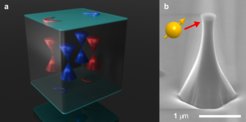Exploring topological superconductivity with single spin magnetic sensor
Topological superconductors are remarkable materials in which the superconducting order is topologically nontrivial. They are of high interest both for the fundamental understanding of quantum effects in strongly-correlated systems and for potential applications in protected quantum devices based on Majorana fermions. Despite decades of experimental and theoretical progress, topological superconductivity has not yet been verified in any material. Recently, Fermi arcs were observed on the surface of Weyl semimetal PtBi2, coexisting with surface superconductivity [1]. This is a promising indication of potential topological superconductivity, but as the effects are limited to the surface and are spatially nonuniform, a local probe is necessary to explore them. An observation of surface magnetism below the superconducting temperature would be a strong indication of topological superconductivity.

In this project, we will image the local magnetic texture of the surface of PtBi2 using a cryogenic magnetometry setup based on the nitrogen-vacancy center. The nitrogen-vacancy (NV) center is an isolated quantum spin trapped in a diamond, of atomic size and with extreme (∼ 10 nT) sensitivity to magnetic field and high spatial resolution (50 nm) [2]. The NV center can operate in a wide temperature range, allowing us to image the magnetic structure across the superconducting transition. Furthermore, quantum spin techniques can be used to probe both static configurations and dynamic fluctuations.
The project combines gaining expertise in a novel quantum sensing technique, and in materials at the frontier of topological quantum phenomena. Through this project, the student can gain expertise in a broad range of topics in condensed matter physics, microscopy, spin physics, and quantum technology.












